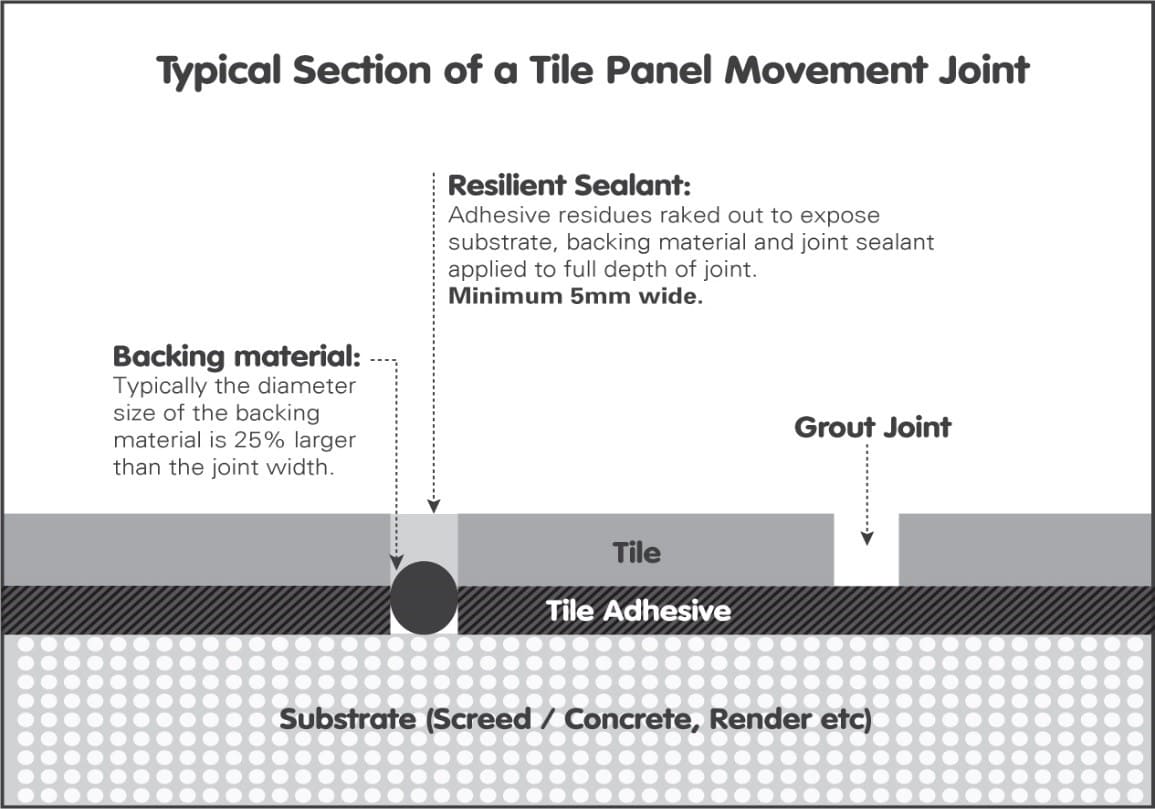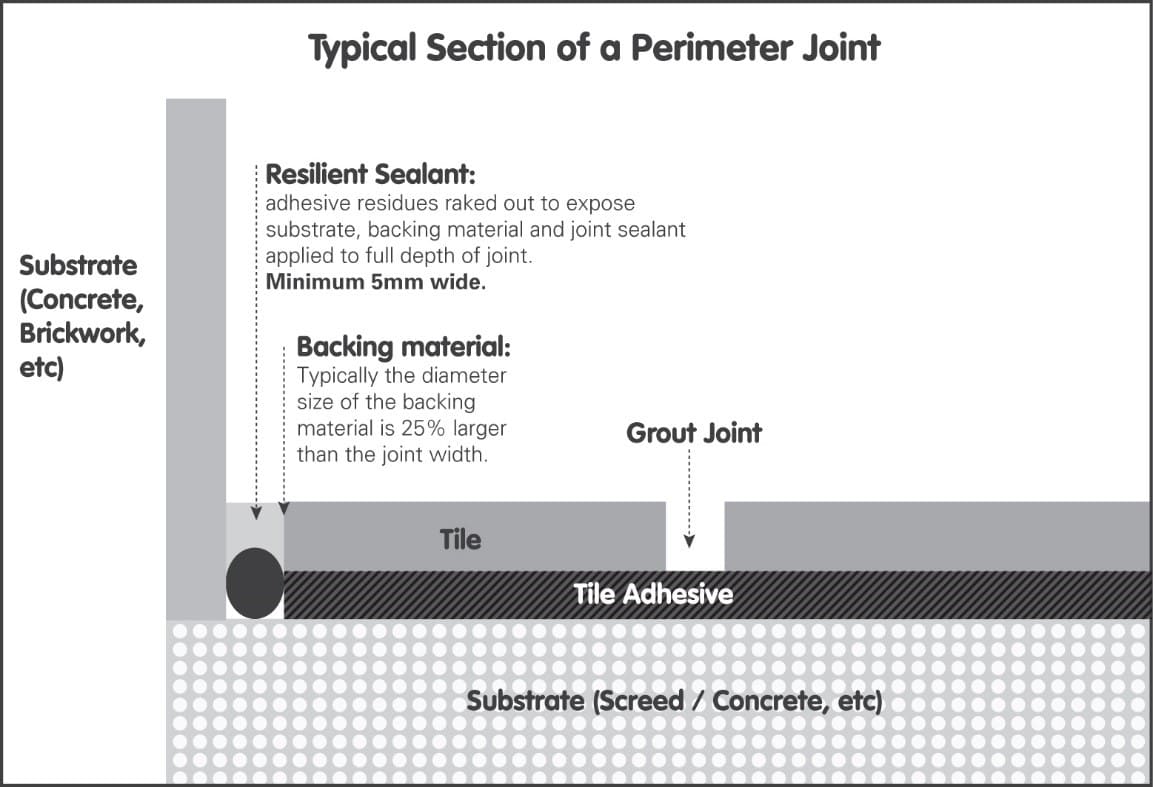General specification for fixing extruded tiles (gail, interbau, nci, vitro, etc) onto interior surface beds and suspended slabs
Please note that ‘general’ specifications are issued for information purposes, and should not be used as project specifications.
As each and every project needs to be assessed individually on its own merits and characteristics please contact the TAL Technical Advice Centre for a project-specific detailed materials and methods specification for specific projects.
It is important that the tile selected is suitable for the application, preferably against a written Supplier’s specification. Factors such as water absorption, irreversible moisture expansion, MOR and PEI ratings, chemical resistance and overall stability of the product need to meet the requirements of the service conditions.
The backs of all tiles must be clean and free from dust and contaminants.
Please note that any “wet” areas, such as showers or balconies, should be waterproofed using TAL SUPERFLEX or TAL SUREPROOF waterproofing compounds prior to commencing tiling. Please feel free to contact us for a specification for waterproofing and tiling these areas, as well as for technical literature on any of our products.
TAL PRODUCT REQUIREMENTS
The TAL products required for this installation are as follows :
TAL WALL & FLOOR GROUT / TAL QUARRYGROUT
NOTCHED FLOOR TROWEL
TAL SEALMASTER CORD
Special note must be taken of the following:
Tiles:
These tiles (extruded, glazed and/or unglazed stoneware) tend to have characteristics similar to those of porcelain tiles, ie low water absorption rates (0.5% or less) and dense bodies, necessitating the use of adhesives with higher bond strengths than conventional (standard-setting) adhesives.
Adhesive System:
We have specified the use of TAL GOLDSTAR 6 rapid setting high strength adhesive for the installation of these tiles. However, if timing on this project allows for a quick setting adhesive option, then TAL GOLDSTAR 12 can be considered.
The advantages of using TAL GOLDSTAR 12 are as follows :
- TAL GOLDSTAR 12 has a longer pot life (pot life of 4 hours, grout after 6 – 8 hours, and traffic after 12 hours)
- TAL GOLDSTAR 12 is more cost effective than TAL GOLDSTAR 6
It is however important that newly installed tiles are protected from traffic (other trades, etc) for a minimum of 12 hours, while the adhesive sets. This is especially important in fast-track installations.
Surface Beds:
All surface beds should have a damp proof membrane (DPM / DPC). Should there be no damp proof membrane below a surface bed or if prevailing moisture levels do not attain 5% (75% RH) or less, it is recommended that TAL X-CALIBUR X-SHIELD VAPORSTOP HB (vapour barrier) be applied prior to tiling to eliminate potential problems associated with excessive moisture in the substrate (such as slow- or non-curing of the adhesive, efflorescence on grout and porous tiles, etc).
TAL X-CALIBUR X-SHIELD VAPORSTOP HB is a moisture tolerant, 100% solids epoxy barrier coat that prevents the passage of water vapour and moisture through concrete slabs.
Please contact TAL for more information on the application of VAPORSTOP HB.
Suspended Applications :
Tiling onto SUSPENDED concrete slabs require special precautions to be taken as the installation is prone to increased movement caused by slab deflection and creep, loading on the slab, etc. TAL BOND or TAL BOND POWDER needs to be incorporated in the adhesive and grout mix, or a single part flexible adhesive such as TAL GOLDFLEX needs to be used to allow for the increased movement.
NOTE : All Ground Floor levels with Basement / Parking levels below should be construed as SUSPENDED slabs.
- BACKGROUND PREPARATION
- Allow all new concrete work and screeds to cure for at least 6 weeks and 4 weeks respectively before proceeding. All new concrete work and screeds must have a moisture content of 5% or less before tiling can be commenced. When tiling directly onto concrete, ensure that the surfaces are clean and free of all traces of curing agents, laitance and any other surface contaminants, preferably by scarifying.
- Any screeding must be firmly attached to the underlying concrete, must be integrally sound (no crumbling, cracking, etc) and must be of a quality and consistency suitable for tiling. All damaged, defective, deteriorated or hollow sounding areas must be removed and the floor made good before proceeding. The surface must be clean and dry and free of all traces of dust, debris, loose particles and surface contaminants.
- If the surface has been woodfloated (rough) it is possible to commence tiling. However, if the surface has been powerfloated or steelfloated (smooth, dense) it will be necessary to first key the surface with a slurry consisting of 1 part TAL KEYCOAT to 2 parts TAL KEYMIX powder or 2 parts TAL GOLDSTAR 6 or 12 powder (by volume), which is applied by block brush. Allow this slurry coat to dry for 4 – 6 hours before applying the adhesive. *
- ADHESIVE SYSTEM
- Surface Beds
- Apply TAL GOLDSTAR 6 rapid-setting adhesive to the background using a notched trowel.
- Suspended Slabs
- Apply TAL GOLDSTAR 6 rapid-setting adhesive mixed 20kg with 5 litres of TAL BOND (replacing the water in the mix) to the background using a notched trowel.
Alternatively, TAL BOND POWDER may be added to the adhesive mixing water at a ratio of 1 x 1kg sachet per 20kg TAL GOLDSTAR 6, or TAL GOLDFLEX single-part flexible rapid-setting adhesive may be used. When using TAL GOLDFLEX no additives are required, simply mix with clean water, alleviating possible mixing errors on site.
- Apply TAL GOLDSTAR 6 rapid-setting adhesive mixed 20kg with 5 litres of TAL BOND (replacing the water in the mix) to the background using a notched trowel.
- General
- In this tiling situation it is imperative that there is a solid bed of adhesive at least 6mm thick beneath each tile. We would recommend the use of a notched FLOOR TROWEL.
- At no time spread more adhesive than can be tiled onto in 10 – 15 minutes. Depending on atmospheric conditions, this will normally be around 1 square metre. This prevents the adhesive from drying or “skinning” before the tiles are applied.
- Bed dry tiles (do not soak) firmly into the wet adhesive with a twisting action to ensure full contact between the background, tiles and adhesive. Tiles should be well tapped home with a rubber mallet or the wooden handle of a trowel. It is sound practice to remove the occasional tile to ensure that good contact has been achieved.
- When using heavily lugged tiles, or tiles with a very irregular back profile, it is good practice to butter the back of each tile, ensuring that the grooves or dovetails are completely filled with adhesive.
- Clean off any surplus adhesive remaining on the face of tiles and between the joints with a damp sponge before the adhesive dries.
- Never butt joint tiles. Joints are required to allow the individual tiles to move with respect to each other and thus avoid a compressive stress build-up. They are also required as vents for the tile adhesive to cure. The joints between these tiles must be a minimum of 5mm wide, or as per manufacturer’s instructions.
- Pot life of the adhesive will vary with climatic conditions. Under no circumstances should adhesive which has been left standing for too long be reconstituted by adding more liquid.
- Do not tile over structural, expansion or cold joints in the background. These joints must be extended through the various layers to the surface.
- Surface Beds
GROUTING
- Grouting must not be carried out until sufficient bond has developed between the bedding mix and the tiles to preclude disturbance of the tiles during the grouting operation. Allow a minimum of 4 hours before grouting.
- Surface Beds
- Use grey or coloured TAL WALL & FLOOR GROUT for filling tile joints up to 8mm wide. For joints wider than 8mm use TAL QUARRYGROUT . TAL QUARRYGROUT is suitable for use in joints up to 25mm wide.
- Suspended Slabs
- Use grey or coloured TAL WALL & FLOOR GROUT mixed 20kg with 6 litres of TAL BOND (replacing the water in the mix) for filling tile joints up to 8mm wide. For joints wider than 8mm use TAL QUARRYGROUT mixed 20kg with 5 litres of TAL BOND (replacing the water in the mix). TAL QUARRYGROUT is suitable for use in joints up to 25mm wide.
Alternatively, TAL BOND POWDER may be added to the grout mixing water, at a ratio of 1 x 1kg sachet per 20kg TAL WALL & FLOOR GROUT / TAL QUARRYGROUT.
- Use grey or coloured TAL WALL & FLOOR GROUT mixed 20kg with 6 litres of TAL BOND (replacing the water in the mix) for filling tile joints up to 8mm wide. For joints wider than 8mm use TAL QUARRYGROUT mixed 20kg with 5 litres of TAL BOND (replacing the water in the mix). TAL QUARRYGROUT is suitable for use in joints up to 25mm wide.
- General / WARNING :
- Particular care must be taken to clean the grout off the tile face before it hardens completely. This is especially important when an additive such as TAL BOND or TAL BOND POWDER has been used.
- NOTE: greater care may be required with some types of tiles, ie those with textured and/or unglazed surfaces.
- A sample of the tiles to be used should be tested beforehand to ensure that no grout is absorbed through the glaze, or into the tile body, causing permanent staining of the tiles.
- It is important to use the stipulated amount of liquid in the TAL Grout mixture. When cleaning, a damp, not wet , sponge must be used. Over hydration (too much water) of the mix, or in cleaning, causes colour variations in the grout joints, and also affects the integrity of the grout, resulting in a friable product.
- MOVEMENT JOINTS
- It should be noted that the lack of movement joints in a tile panel is a major cause of tile failure. They should be specified at the design stage to avoid placing them in heavy traffic areas and spoiling the visual effect of the tiles.
- Movement joints should be located in both directions at maximum 3 metre centres for this application.
- Movement joints should also be located around the perimeter of all floors, in all vertical corners, against obstructions fixed to the structural background and over all discontinuities in building materials, e.g. at interfaces of concrete and wooden panels, concrete and brickwork, etc. In addition, movement joints should be located around any fixtures protruding through the tiled surface such as columns or stairs.
- The joints should be at least 5mm wide and extend through the adhesive and tile layers. All construction / cold joints and structural joints in the background must be extended through the adhesive and tile layers to the surface in the form of tile panel movement joints. With regards to structural joints, the full width of the structural joints must be respected and extended through the adhesive and tile layers to the surface.
- Where practical, the bulk of the depth of the movement joint can be filled with TAL SEALMASTER CORD.
- Seal the joint using TAL GOLDSTAR SEALMASTER 1000 polyurethane joint sealant in accordance with the manufacturer’s instructions. It is important that the joint sealant bonds only to the sides of the movement joint.
- For the key requirements common to all tiling situations please refer to SANS 10107-2011, Code of Practice for the Design and Installation of Ceramic Tiling.
-
- NOTE : This installation must be allowed to set sufficiently before being trafficked.


Should you require any further assistance or have any queries regarding the above, please do not hesitate to contact us. Assuring you of our best attention at all times.
Yours faithfully,
SHARON MARGON
TECHNICAL ADVICE SUPERVISOR
© TAL 1972 & 1984